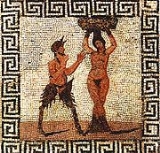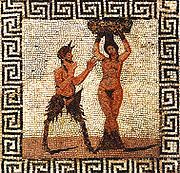
Hamadryad
Encyclopedia

Greek mythology
Greek mythology is the body of myths and legends belonging to the ancient Greeks, concerning their gods and heroes, the nature of the world, and the origins and significance of their own cult and ritual practices. They were a part of religion in ancient Greece...
beings that live in tree
Tree
A tree is a perennial woody plant. It is most often defined as a woody plant that has many secondary branches supported clear of the ground on a single main stem or trunk with clear apical dominance. A minimum height specification at maturity is cited by some authors, varying from 3 m to...
s. They are a particular type of dryad
Dryad
Dryads are tree nymphs in Greek mythology. In Greek drys signifies 'oak,' from an Indo-European root *derew- 'tree' or 'wood'. Thus Dryads are specifically the nymphs of oak trees, though the term has come to be used for all tree nymphs in general...
, which in turn are a particular type of nymph
Nymph
A nymph in Greek mythology is a female minor nature deity typically associated with a particular location or landform. Different from gods, nymphs are generally regarded as divine spirits who animate nature, and are usually depicted as beautiful, young nubile maidens who love to dance and sing;...
. Hamadryads are born bonded to a particular tree. Some believe that hamadryads are the actual tree, while normal dryad
Dryad
Dryads are tree nymphs in Greek mythology. In Greek drys signifies 'oak,' from an Indo-European root *derew- 'tree' or 'wood'. Thus Dryads are specifically the nymphs of oak trees, though the term has come to be used for all tree nymphs in general...
s are simply the entities
Entity
An entity is something that has a distinct, separate existence, although it need not be a material existence. In particular, abstractions and legal fictions are usually regarded as entities. In general, there is also no presumption that an entity is animate.An entity could be viewed as a set...
, or spirits, of the trees. If the tree died, the hamadryad associated with it died as well. For that reason, dryads and the gods punished any mortal
Human
Humans are the only living species in the Homo genus...
s who harmed trees. The Deipnosophistae of Athenaeus
Deipnosophistae
The Deipnosophistae may be translated as The Banquet of the Learned or Philosophers at Dinner or The Gastronomers...
lists eight Hamadryads, the daughters of Oxylus
Oxylus
In Greek mythology, Oxylus may refer to:*A son of Ares and Protogeneia, daughter of Calydon.*An one-eyed man from Aetolia, son of Haemon or of Andraemon. He was exiled from Aetolia on account of unintentional homicide; his victim was either his own brother Therimus or a certain Alcidocus, son of...
and Hamadryas:
- Karya (WalnutWalnutJuglans is a plant genus of the family Juglandaceae, the seeds of which are known as walnuts. They are deciduous trees, 10–40 meters tall , with pinnate leaves 200–900 millimetres long , with 5–25 leaflets; the shoots have chambered pith, a character shared with the wingnuts , but not the hickories...
or HazelnutHazelnutA hazelnut is the nut of the hazel and is also known as a cob nut or filbert nut according to species. A cob is roughly spherical to oval, about 15–25 mm long and 10–15 mm in diameter, with an outer fibrous husk surrounding a smooth shell. A filbert is more elongated, being about twice...
) - Balanos (OakOakAn oak is a tree or shrub in the genus Quercus , of which about 600 species exist. "Oak" may also appear in the names of species in related genera, notably Lithocarpus...
) - Kraneia (DogwoodDogwoodThe genus Cornus is a group of about 30-60 species of woody plants in the family Cornaceae, commonly known as dogwoods. Most dogwoods are deciduous trees or shrubs, but a few species are nearly herbaceous perennial subshrubs, and a few of the woody species are evergreen...
) - Morea (MulberryMulberryMorus is a genus of flowering plants in the family Moraceae. The 10–16 species of deciduous trees it contains are commonly known as Mulberries....
) - Aigeiros (Black PoplarBlack PoplarPopulus nigra, the black poplar, is a species of cottonwood poplar, the type species of section Aigeiros of the genus Populus, native to Europe, southwest and central Asia, and northwest Africa....
) - Ptelea (ElmElmElms are deciduous and semi-deciduous trees comprising the genus Ulmus in the plant family Ulmaceae. The dozens of species are found in temperate and tropical-montane regions of North America and Eurasia, ranging southward into Indonesia. Elms are components of many kinds of natural forests...
) - Ampelos (Vines, especially VitisVitisVitis is a genus of about 60 species of vining plants in the flowering plant family Vitaceae. The genus is made up of species predominantly from the Northern hemisphere. It is economically important as the source of grapes, both for direct consumption of the fruit and for fermentation to produce...
) - Syke (FigFicusFicus is a genus of about 850 species of woody trees, shrubs, vines, epiphytes, and hemiepiphyte in the family Moraceae. Collectively known as fig trees or figs, they are native throughout the tropics with a few species extending into the semi-warm temperate zone. The Common Fig Ficus is a genus of...
)
Their mother, Hamadryas, is immortalized in the name of two genera, that of the Cracker butterfly, of the northernmost monkey in Asia Minor
Asia Minor
Asia Minor is a geographical location at the westernmost protrusion of Asia, also called Anatolia, and corresponds to the western two thirds of the Asian part of Turkey...
, the Hamadryas baboon
Hamadryas Baboon
The Hamadryas baboon is a species of baboon from the Old World monkey family. It is the northernmost of all the baboons; being native to the Horn of Africa and the southwestern tip of the Arabian Peninsula. These regions provide habitats with the advantage for this species of fewer natural...
. The Cracker Butterfly is more arboreal than most butterflies, as it commonly camouflages itself on trees. It feeds not on nectar but on sap, rotting fruit and dung. The Hamadryas baboon however is one of the least arboreal monkeys but it was the most common monkey in Hellenic
Hellenic
Hellenic is a synonym for Greek and may refer to:* Hellenic languages* Hellenic Airlines* Hellenic College, a liberal arts college in Brookline, Massachusetts* Hellenic College of London* Hellenic FC, a football club in South Africa...
lands.
Hamadryad is referenced as a whole in Edgar Allan Poe
Edgar Allan Poe
Edgar Allan Poe was an American author, poet, editor and literary critic, considered part of the American Romantic Movement. Best known for his tales of mystery and the macabre, Poe was one of the earliest American practitioners of the short story and is considered the inventor of the detective...
's poem, "Sonnet To Science."
Hamadryad is referenced in Anthony Ashley Cooper's (The Third Earl of Shaftesbury)Characteristics (1714: Treatise 4 Part 3 Section 1).

